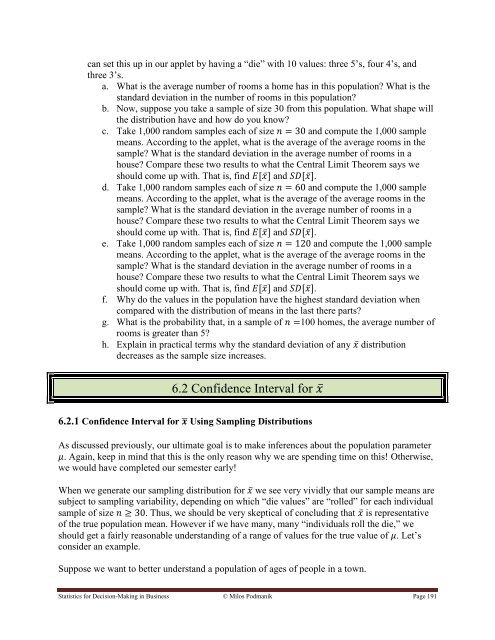Statistics for Decision- Making in Business - Maricopa Community ...
Statistics for Decision- Making in Business - Maricopa Community ...
Statistics for Decision- Making in Business - Maricopa Community ...
Create successful ePaper yourself
Turn your PDF publications into a flip-book with our unique Google optimized e-Paper software.
can set this up <strong>in</strong> our applet by hav<strong>in</strong>g a “die” with 10 values: three 5‟s, four 4‟s, and<br />
three 3‟s.<br />
a. What is the average number of rooms a home has <strong>in</strong> this population What is the<br />
standard deviation <strong>in</strong> the number of rooms <strong>in</strong> this population<br />
b. Now, suppose you take a sample of size 30 from this population. What shape will<br />
the distribution have and how do you know<br />
c. Take 1,000 random samples each of size and compute the 1,000 sample<br />
means. Accord<strong>in</strong>g to the applet, what is the average of the average rooms <strong>in</strong> the<br />
sample What is the standard deviation <strong>in</strong> the average number of rooms <strong>in</strong> a<br />
house Compare these two results to what the Central Limit Theorem says we<br />
should come up with. That is, f<strong>in</strong>d , ̅- and , ̅-.<br />
d. Take 1,000 random samples each of size and compute the 1,000 sample<br />
means. Accord<strong>in</strong>g to the applet, what is the average of the average rooms <strong>in</strong> the<br />
sample What is the standard deviation <strong>in</strong> the average number of rooms <strong>in</strong> a<br />
house Compare these two results to what the Central Limit Theorem says we<br />
should come up with. That is, f<strong>in</strong>d , ̅- and , ̅-.<br />
e. Take 1,000 random samples each of size and compute the 1,000 sample<br />
means. Accord<strong>in</strong>g to the applet, what is the average of the average rooms <strong>in</strong> the<br />
sample What is the standard deviation <strong>in</strong> the average number of rooms <strong>in</strong> a<br />
house Compare these two results to what the Central Limit Theorem says we<br />
should come up with. That is, f<strong>in</strong>d , ̅- and , ̅-.<br />
f. Why do the values <strong>in</strong> the population have the highest standard deviation when<br />
compared with the distribution of means <strong>in</strong> the last there parts<br />
g. What is the probability that, <strong>in</strong> a sample of 100 homes, the average number of<br />
rooms is greater than 5<br />
h. Expla<strong>in</strong> <strong>in</strong> practical terms why the standard deviation of any ̅ distribution<br />
decreases as the sample size <strong>in</strong>creases.<br />
6.2 Confidence Interval <strong>for</strong> ̅<br />
6.2.1 Confidence Interval <strong>for</strong> ̅ Us<strong>in</strong>g Sampl<strong>in</strong>g Distributions<br />
As discussed previously, our ultimate goal is to make <strong>in</strong>ferences about the population parameter<br />
. Aga<strong>in</strong>, keep <strong>in</strong> m<strong>in</strong>d that this is the only reason why we are spend<strong>in</strong>g time on this! Otherwise,<br />
we would have completed our semester early!<br />
When we generate our sampl<strong>in</strong>g distribution <strong>for</strong> ̅ we see very vividly that our sample means are<br />
subject to sampl<strong>in</strong>g variability, depend<strong>in</strong>g on which “die values” are “rolled” <strong>for</strong> each <strong>in</strong>dividual<br />
sample of size . Thus, we should be very skeptical of conclud<strong>in</strong>g that ̅ is representative<br />
of the true population mean. However if we have many, many “<strong>in</strong>dividuals roll the die,” we<br />
should get a fairly reasonable understand<strong>in</strong>g of a range of values <strong>for</strong> the true value of . Let‟s<br />
consider an example.<br />
Suppose we want to better understand a population of ages of people <strong>in</strong> a town.<br />
<strong>Statistics</strong> <strong>for</strong> <strong>Decision</strong>-<strong>Mak<strong>in</strong>g</strong> <strong>in</strong> Bus<strong>in</strong>ess © Milos Podmanik Page 191
















